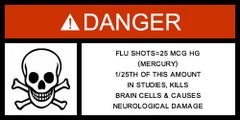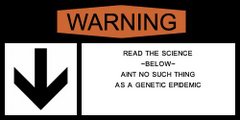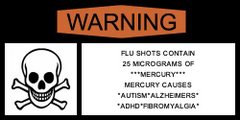Tim and Laura Kasemodel are an exceptional couple who live in Minnesota. I have had the pleasure of knowing the Kazemodel family for a few years, sharing many advocacy stories.
At any time there are bills introduced in Minnesota that might impact the autism community, you can be sure to find Tim and Laura at the capital. I would wager to bet that there are very few lawmakers who have not met the Kazemodel family, and I am sure Minnesotans would be hard-pressed to find them missing a chance to testify on behalf of our kids.
Tim and Laura are incredible autism advocates, but more than that, they are incredible friends. With pleasure, please here's one of my favorites by Tim:
Another National Tragedy: Self Protection at the CDC
A Unique Viewpoint
On February 22, 2006, a bi-partisan letter was sent by Congressional leaders in the House and Senate to David Schwartz, Director of the National Institute of Environmental Health Sciences. The letter from Senator Joseph Lieberman and others informs Mr. Schwartz of pending legislation that would order a new look at the connection between mercury containing vaccines and autism.
In 2004, the Institute of Medicine released a report rejecting a connection between the ethyl mercury in thimerosal containing vaccines and autism. The letter to the NIEHS mentioned that for many others, the issue remains unresolved. So why do so many legislators, parents, physicians and researchers disagree? Consider this comparison between two large government agencies: the Centers for Disease Control and the National Aeronautics and Space Administration.
The CDC and NASA have much in common. Both are large multi layered bureaucratic agencies. They are strong symbols of national pride, and both are well funded by the U.S. taxpayer. The directors of each program are appointed, not elected. They also once shared the enviable position of the oversight of their own safety programs. Both have since been stripped of this self oversight.
For a more detailed similarity, let us start with NASA. In the wee hours of darkness the morning of January 28, 1986, NASA officials lobbied hard for the launch of the Space Shuttle Challenger. There had already been several delays of the launch and NASA was concerned public confidence and support for the program was waning. Another delay in the launch would damage public opinion. Other factors included economic considerations, political pressures, and scheduling backlogs. President Reagan also wanted to be able to mention the successful launch of the shuttle in his State of the Union Address that evening. For several hours, engineers at the firm that had designed the o-rings for the solid rocket boosters refused to sign off on the OK to launch, because tests of the boosters had never been performed below 40°F. They believed strongly that the o-rings would crack and fail at the 27°F temperature forecast for lift off, however, they could not prove that it was unsafe to launch at lower temperatures.
Rather than being concerned about the proof of safety, NASA officials pressed the upper management of the engineering firm. The data presented to them showed no correlation between temperature and the blow-by gases which had eroded the O-rings in previous missions. According to testimony, the firm’s senior executive finally turned to the Engineering Vice President and said, "Take off your engineering hat and put on your management hat." The upper management of the engineering firm by-passed the engineers and decided to approve the boosters for launch despite the fact that the predicted launch temperature was outside of their operational specifications.
(see http://ethics.tamu.edu/ethics/shuttle/shuttle1.htm)
We all know that NASA’s disregard for safety and the engineers’ decision to change hats ended in explosive disaster that day. When causes for this tragedy were looked at, NASA initially tried to hide the fact that the o-rings were a concern. After a lengthy investigation NASA finally came clean, putting the protection of their astronauts first, and protection of their pride last. They were able to take care of the problem and resume further shuttle missions.
The CDC has a very similar story to tell. In 1999, the FDA finally added up the mercury burden from the ethyl mercury based preservative thimerosal in the childhood vaccine schedule. They were concerned enough to ask, along with the American Academy of Pediatrics, that the CDC recommend the removal of thimerosal from vaccines as soon as possible. Parents were shocked to find that there was mercury in children’s vaccines, with totals averaging 250 micrograms by age two. Soon parents, physicians and researchers began to raise the reasonable concern that the mercury in vaccines may have been responsible for the meteoric rise in the rate of autism and other neurological disorders. The CDC has continued to deny any possible link and declared that there is no proof. The fact is, just as with the o-rings on the space shuttle, proper safety testing was never done on the ethyl mercury in thimerosal. There have been over a thousand studies and reports in the last seventy years indicating the problems with thimerosal, though none were done to determine a safe dose level if injected.
Just as with NASA, the CDC was careful not to disclose all that they knew. In June of 2000, CDC researcher Thomas Verstraeten reported on a Vaccine Safety Datalink analysis of thimerosal-containing vaccines and neurodevelopmental outcomes. He initially showed statistically significant relationships between the mercury exposures and outcomes for autism, along with the entire category of neurodevelopmental delays and a number of other disorders.
With a high rate of relative risk of autism staring him in the face, Dr Verstraeten altered data criteria many times but found “it just won’t go away”. Dr. Walter Orenstein, the acting director of the CDC’s National Immunization program, had gone so far as to declare discussions on this early data to be confidential and embargoed. Keeping public faith in the national vaccine program was paramount. They were concerned that vaccination rates would drop if people believed the mercury in vaccines could cause autism and other disorders. The study data was finally manipulated until it showed no plausible link to autism.
(see http://www.cdc.gov/nip/news/simptrans072005.htm)
In 2004, the CDC asked the Institute of Medicine to review the available studies to determine if a link between Thimerosal and neurological disorders was plausible. Like NASA, the IOM listened to many researchers explain how ethyl mercury could be causing an epidemic of autism and other disorders among children. The review committee critiqued and discounted nearly all of those biological studies, saying none of them proved thimerosal caused autism or other developmental disorders. The committee based the bulk of its conclusions on five epidemiological studies conducted by the CDC and European counterparts. Epidemiological studies cannot be used to prove or disprove a link, only to suggest plausibility. Regardless, the IOM made with a statement that vaccines were not linked to the rise in autism, and stated that research into the link should be discontinued.
As a result of this action, the CDC has convinced the public to ignore its own explosive disaster. By the time thimerosal was removed, the national rate of autism skyrocketed from 1 in 10,000 to 1 in 150. The rate of children using special education services with the diagnosis of autism in Minnesota in 2006 is now 1 in 109. NASA’s mistake took a millisecond; the CDC’s mistake lasted over a decade. NASA lost 7 brave astronauts. The CDC has lost half a million children.
In these examples the two agencies shared common traits. Concern over the image of their programs seems to have priority over common sense. Testing that considered the actual conditions of use were not done, so assumptions were made about the safety of what turned out to be critical components of their programs. Authority figures had ignored the pleas of researchers or engineers reporting on the consequences of those assumptions. In the end, it appears that decisions made by a few people had affected the entire nation in ways they could not have imagined.
Since the 2004 IOM report, several important publicly and privately funded studies have been published which show a strong link between ethyl mercury exposure and neurological disorders like autism. These studies continue to be ignored by those who defend the use of mercury in vaccines. Researchers now report a decline in new cases of autism and speech disorders in direct correlation with the removal of thimerosal.
Ironically, the CDC is once again recommending a flu vaccine, ninety percent of which contains mercury, be given annually to children 5 and under. It is time for CDC officials to take off their management hats, put on their common sense and science hats, and take a long, hard look at the newest information. It is time to come clean, put the protection of the public first, and put the protection of their pride last.
The CDC should be recommending mercury free vaccines for everyone, at every age. It is possible in almost every situation, and it is common sense.
Tim Kasemodel
A Unique Viewpoint
On February 22, 2006, a bi-partisan letter was sent by Congressional leaders in the House and Senate to David Schwartz, Director of the National Institute of Environmental Health Sciences. The letter from Senator Joseph Lieberman and others informs Mr. Schwartz of pending legislation that would order a new look at the connection between mercury containing vaccines and autism.
In 2004, the Institute of Medicine released a report rejecting a connection between the ethyl mercury in thimerosal containing vaccines and autism. The letter to the NIEHS mentioned that for many others, the issue remains unresolved. So why do so many legislators, parents, physicians and researchers disagree? Consider this comparison between two large government agencies: the Centers for Disease Control and the National Aeronautics and Space Administration.
The CDC and NASA have much in common. Both are large multi layered bureaucratic agencies. They are strong symbols of national pride, and both are well funded by the U.S. taxpayer. The directors of each program are appointed, not elected. They also once shared the enviable position of the oversight of their own safety programs. Both have since been stripped of this self oversight.
For a more detailed similarity, let us start with NASA. In the wee hours of darkness the morning of January 28, 1986, NASA officials lobbied hard for the launch of the Space Shuttle Challenger. There had already been several delays of the launch and NASA was concerned public confidence and support for the program was waning. Another delay in the launch would damage public opinion. Other factors included economic considerations, political pressures, and scheduling backlogs. President Reagan also wanted to be able to mention the successful launch of the shuttle in his State of the Union Address that evening. For several hours, engineers at the firm that had designed the o-rings for the solid rocket boosters refused to sign off on the OK to launch, because tests of the boosters had never been performed below 40°F. They believed strongly that the o-rings would crack and fail at the 27°F temperature forecast for lift off, however, they could not prove that it was unsafe to launch at lower temperatures.
Rather than being concerned about the proof of safety, NASA officials pressed the upper management of the engineering firm. The data presented to them showed no correlation between temperature and the blow-by gases which had eroded the O-rings in previous missions. According to testimony, the firm’s senior executive finally turned to the Engineering Vice President and said, "Take off your engineering hat and put on your management hat." The upper management of the engineering firm by-passed the engineers and decided to approve the boosters for launch despite the fact that the predicted launch temperature was outside of their operational specifications.
(see http://ethics.tamu.edu/ethics/shuttle/shuttle1.htm)
We all know that NASA’s disregard for safety and the engineers’ decision to change hats ended in explosive disaster that day. When causes for this tragedy were looked at, NASA initially tried to hide the fact that the o-rings were a concern. After a lengthy investigation NASA finally came clean, putting the protection of their astronauts first, and protection of their pride last. They were able to take care of the problem and resume further shuttle missions.
The CDC has a very similar story to tell. In 1999, the FDA finally added up the mercury burden from the ethyl mercury based preservative thimerosal in the childhood vaccine schedule. They were concerned enough to ask, along with the American Academy of Pediatrics, that the CDC recommend the removal of thimerosal from vaccines as soon as possible. Parents were shocked to find that there was mercury in children’s vaccines, with totals averaging 250 micrograms by age two. Soon parents, physicians and researchers began to raise the reasonable concern that the mercury in vaccines may have been responsible for the meteoric rise in the rate of autism and other neurological disorders. The CDC has continued to deny any possible link and declared that there is no proof. The fact is, just as with the o-rings on the space shuttle, proper safety testing was never done on the ethyl mercury in thimerosal. There have been over a thousand studies and reports in the last seventy years indicating the problems with thimerosal, though none were done to determine a safe dose level if injected.
Just as with NASA, the CDC was careful not to disclose all that they knew. In June of 2000, CDC researcher Thomas Verstraeten reported on a Vaccine Safety Datalink analysis of thimerosal-containing vaccines and neurodevelopmental outcomes. He initially showed statistically significant relationships between the mercury exposures and outcomes for autism, along with the entire category of neurodevelopmental delays and a number of other disorders.
With a high rate of relative risk of autism staring him in the face, Dr Verstraeten altered data criteria many times but found “it just won’t go away”. Dr. Walter Orenstein, the acting director of the CDC’s National Immunization program, had gone so far as to declare discussions on this early data to be confidential and embargoed. Keeping public faith in the national vaccine program was paramount. They were concerned that vaccination rates would drop if people believed the mercury in vaccines could cause autism and other disorders. The study data was finally manipulated until it showed no plausible link to autism.
(see http://www.cdc.gov/nip/news/simptrans072005.htm)
In 2004, the CDC asked the Institute of Medicine to review the available studies to determine if a link between Thimerosal and neurological disorders was plausible. Like NASA, the IOM listened to many researchers explain how ethyl mercury could be causing an epidemic of autism and other disorders among children. The review committee critiqued and discounted nearly all of those biological studies, saying none of them proved thimerosal caused autism or other developmental disorders. The committee based the bulk of its conclusions on five epidemiological studies conducted by the CDC and European counterparts. Epidemiological studies cannot be used to prove or disprove a link, only to suggest plausibility. Regardless, the IOM made with a statement that vaccines were not linked to the rise in autism, and stated that research into the link should be discontinued.
As a result of this action, the CDC has convinced the public to ignore its own explosive disaster. By the time thimerosal was removed, the national rate of autism skyrocketed from 1 in 10,000 to 1 in 150. The rate of children using special education services with the diagnosis of autism in Minnesota in 2006 is now 1 in 109. NASA’s mistake took a millisecond; the CDC’s mistake lasted over a decade. NASA lost 7 brave astronauts. The CDC has lost half a million children.
In these examples the two agencies shared common traits. Concern over the image of their programs seems to have priority over common sense. Testing that considered the actual conditions of use were not done, so assumptions were made about the safety of what turned out to be critical components of their programs. Authority figures had ignored the pleas of researchers or engineers reporting on the consequences of those assumptions. In the end, it appears that decisions made by a few people had affected the entire nation in ways they could not have imagined.
Since the 2004 IOM report, several important publicly and privately funded studies have been published which show a strong link between ethyl mercury exposure and neurological disorders like autism. These studies continue to be ignored by those who defend the use of mercury in vaccines. Researchers now report a decline in new cases of autism and speech disorders in direct correlation with the removal of thimerosal.
Ironically, the CDC is once again recommending a flu vaccine, ninety percent of which contains mercury, be given annually to children 5 and under. It is time for CDC officials to take off their management hats, put on their common sense and science hats, and take a long, hard look at the newest information. It is time to come clean, put the protection of the public first, and put the protection of their pride last.
The CDC should be recommending mercury free vaccines for everyone, at every age. It is possible in almost every situation, and it is common sense.
Tim Kasemodel



